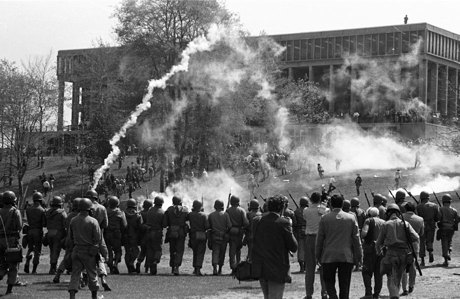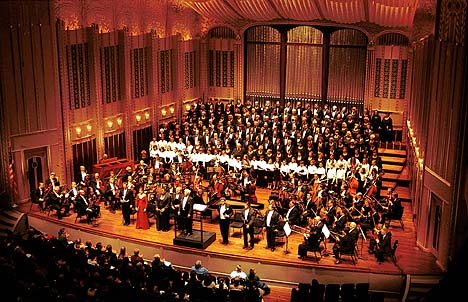solo soprano, chorus, 6 choral soloists and picc3342/4331/harp/4 percussion/strings
Commissioned and premiered by the Cleveland Orchestra and Kent State University
Duration: 22 minutes

Song in Sorrow was commissioned by Kent State University and The Cleveland Orchestra in commemoration of the 30th anniversary of the shootings on the Kent State campus. Thomas assembled the text of her work from a wide variety of sources as indicated below. Song in Sorrow runs about 20 minutes in performance and is scored for the following forces: solo soprano, 6 chorus soloists (4 sopranos and 2 altos), plus an orchestra consisting of piccolo, 3 flutes, 3 oboes, 3 clarinets, bassoon, 4 horns, 3 trumpets (one doubling piccolo trumpet), trombone, percussion (2 vibraphones, 2 triangles, 2 glockenspiels, 2 suspended cymbals, 2 conga drums, large tam-tam, marimba, crotales, 4 bongos, 2 woodblocks, tubular chimes, bass drum), harp, and strings.
Song in Sorrow is Thomas's second work to combine choral and orchestral forces (her Ring Out Wild Bells was premiered by the Choral Arts Society of Washington at the Kennedy Center). In this work, Thomas makes the cantata genre thoroughly her own, and uses it to express her deep-seated anti-war feelings and her empathy with human suffering everywhere. Even before she had written the first note of her piece, Thomas knew it would be programmed together with Beethoven's Ninth for its premiere. The conceptual rhyme between Thomas's Song in Sorrow and Beethoven's Ode to Joy was planned from the start as the underlying motive of the entire evening.
This is how Augusta Read Thomas remembers hearing the news of Kent State for the first time:
"On May 4, 1970, my sixth birthday had just passed and I remember the nightly conversations about the draft as we sat to eat family dinner in the kitchen. At the time, I did not understand the words "the draft" but I knew that it meant my three older brothers (all born in the early 1950s) would have to go to fight in a bad war. This was very scary to me at age six. The thought that mankind is still engaged in wars and slaughter remains hideous and terrifying."
Years later, Thomas visited the site at Kent:
"The granite memorial at Kent State University, surrounded by 58,175 daffodil bulbs, which symbolize the number of our country's losses in Vietnam, reads "Inquire, Learn, Reflect." These three words inspired Song in Sorrow's three movements (which are played without a pause and form a slow/fast/slow arch): Sing Again, Black Despair, and When Soft Voices Die. (All titles are takes from poems by Percy Bysshe Shelley.)"
The tragic events of May 4, 1970, invited Thomas to reflect on "freedom, responsibility, democracy, love, grace, death, life, pain, humility, tragedy, forgiveness, universality" — themes considered in the text and music of Song in Sorrow. To express these themes musically, Thomas turned to about thirty different literary sources including 4000-year-old Sumerian fragments, Dante, Shakespeare, Milton, Shelley, Keats, and many others. With extreme care, Thomas extracted fragments from these sources, freely repeating and rearranging the words which fit together like pieces of a mosaic. Each fragment is like a strong beam of light, illuminating one particular idea or feeling. The musical sections likewise string together strongly articulated emotions — tenderness, passion, grief, anger, despair and quiet composure — in a compelling sequence. Yet Thomas created a powerful sense of cohesion among the different quotes, moving seamlessly from one fragment to the next, sometimes even reaching back to previous ones or anticipating words from fragments yet to come.
In a recent interview, Thomas said: "All music of substance should have an immediacy about it...an impressive presence." One feels this immediacy in every measure of Song in Sorrow. The musical means used to express each emotion are so intimately wedded to the words that their meaning comes across clearly and effortlessly. The three-tiered arrangement of the vocal forces (main soloist, soloists from the chorus and the chorus itself) emphasizes the private and public aspects of the underlying emotions. As the composer has explained,
"The six solo female voices, which stand near the solo soprano at the front of the stage, take her text and music, vocally and gracefully expanding them from the specificity of an individual voice out into a collective, community ceremony. The large chorus provides the same expansion taken one step further toward universal observance....There are [also] several solos in the front desk string parts which thread through the opening and closing movements. These symbolize the distant voices of the 4 dead students: Jeffrey Miller, Allison Krause, William Schroeder, and Sandra Scheuer."
As the work progresses from the lament of the first movement to the passionate outcry of the second and the final song of consolation, a number of musical symbols are used to convey the meaning of May 4, 1970. Thomas pointed out two of these:

"The first is the tolling of the victory bell, which was rung by the crowds and also served as their meeting place. The composition opens with large orchestral bell strokes and through out the entire piece, in different contexts, supporting specific texts, you will hear bells ringing. The most obvious occasion is at the end of movement I when the solo soprano sings the text by Li Shang-Yin "We hear all past and future in one stroke of the temple bell " and behind her, you her the chimes tolling like a forgotten echo. [Secondly,] the crowd was shouting: "1,2,3,4. We don't want your f—ing war." The rhythm of this chant finds its way into the rhythmic structures of the music.
"In fact, the last thing we hear at the end of the piece is a quiet allusion to the rhythm of this slogan (slightly modified), played by the strings col legno (with the wood of the bow) and reinforced by the marimba. The juxtaposition with the prayer words, sung simultaneously by the chorus ("earth to earth, ashes to ashes, dust to dust"), may be startling, but it encapsulates the basic duality expressed in the piece: a requiem for the victims and a protest against the circumstances that caused their deaths.
"It is my hope that this composition can modestly reflect upon the totality and universality of the tragedy which took place at Kent State University, as well as the grave adversity and suffering that took place in Cambodia, Vietnam, and throughout mankind's history of bloodshed and warfare."
The following four mottoes are inscribed on the first page of the score:
Poets are the hierophants of an unapprehended inspiration; the mirrors of the gigantic shadows which futurity casts upon the present.
— Percy Bysshe Shelley
There are two things that will always be very difficult for a democratic nation: to start a war and to end it.
— Alexis de Tocqueville
Undoubtedly war is the greatest source of the evils which oppress civilized nations; not so much actual war, but rather the never-ceasing and indeed ever-increasing preparation for a future war. All the resources of the state are used to this end, as well as all the fruits of its culture, which might instead be used for the creation of a still greater culture.
— Immanuel Kant
A riot is the language of the unheard.
— Martin Luther King
Elaine Guregian, Akron Beacon Journal, 3 July 2000
"ELEGANT COMPOSITION PAYS TRIBUTE TO MAY 4, 1970
Thomas' new composition held its own next to Beethoven's iconic one. Song in Sorrow is an elegant work of extraordinary focus and clarity with a wealth of well-chosen texts. Thomas has an ear for the sensuous qualities of the orchestra. Her modernity is organic and never tries too hard to shock."

To obtain examination or performance material for any of
Augusta Read Thomas's works, please contact G. Schirmer Inc..
